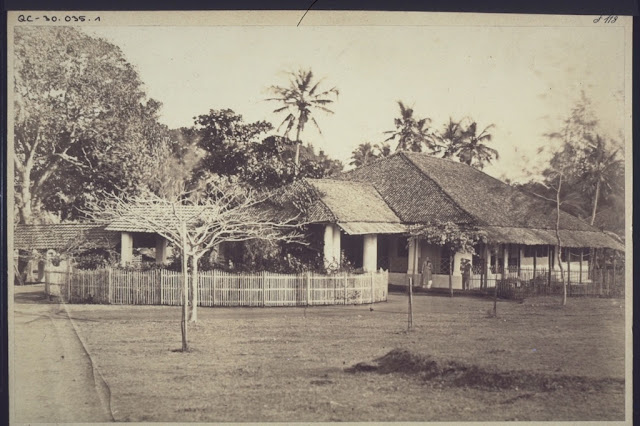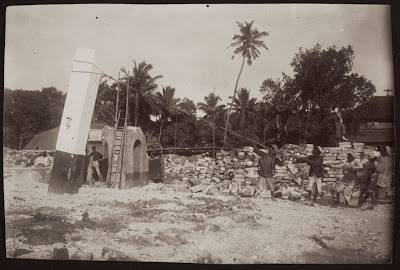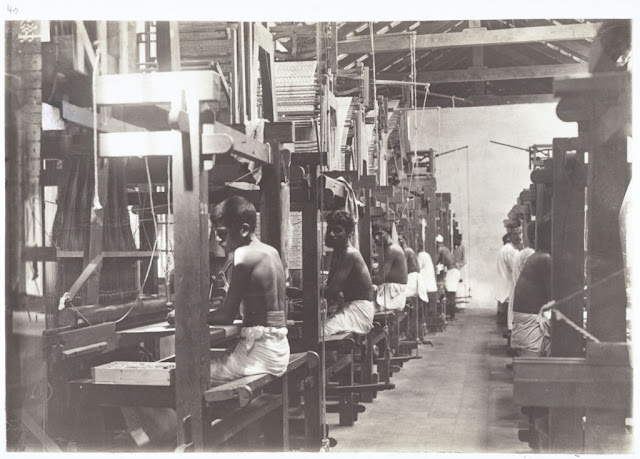Kannur- Land of Looms, A historical approach
Woven cloth
The tradition of making woven cloth dates back to Rig Vedic period. Authentic accounts about the
inhabitants of the Indus Valley Civilization used cotton for clothing as early as the 5th millennium BC – 4th millennium BC.
According to The Columbia Encyclopedia, Sixth Edition:
"Cotton has been spun, woven, and dyed since prehistoric times. It clothed the people of ancient India, Egypt, and China. Hundreds of years before the Christian era cotton textiles were woven in India with matchless skill, and their use spread to the Mediterranean countries. In the 1st cent. Arab traders brought fine Muslin and Calico to Italy and Spain. The Moors introduced the cultivation of cotton into Spain in the 9th cent. Fustians and dimities were woven there and in the 14th cent. in Venice and Milan, at first with a linen warp. Little cotton cloth was imported to England before the 15th cent., although small amounts were obtained chiefly for candlewicks. By the 17th cent. theEast India Company was bringing rare fabrics from India. Native Americans skillfully spun and wove cotton into fine garments and dyed tapestries. Cotton fabrics found in Peruvian tombs are said to belong to a pre-Inca culture. In colour and texture the ancient Peruvian and Mexican textiles resemble those found in Egyptian tombs."
South India
Basel Mission brought about a major breakthrough in Handloom sector at the time of British rule in 1844. Basel Mission first setup the Handloom weaving factories in Mangalore in 1844 and subsequently in Cannanore and Calicut in 1852. It brought the handlooms popular in Manchester, UK and adapted to Indian conditions to run the Handloom weaving factories in the modern line. With the success of these weaving units, some of the wealthy families in the areas ventured into Handloom weaving factories, mainly focusing in the manufacture of dress materials and casements. Handloom industries suffered a setback after the Second World War and most of the factories were closed.
Title: "A difficult load with machinery on the beach in Cannanore."
Creator: unknown
Date: NA( Probably before 1890)
Please note the heavy machinery shipped from Europe and the method to embark ship to the boat and to the land of Kannur. ...It may be a historical moment. The place is not known but we believe it is in present Ayikkara beach popularly known as Mappila Bay at Kannur city, just in front of Arakkal palace. In the background, we assume, the fort of Saint Angelo.
note the costume of Men and how they enjoy.
Creator: unknown
Date: NA( Probably before 1890)
Please note the heavy machinery shipped from Europe and the method to embark ship to the boat and to the land of Kannur. ...It may be a historical moment. The place is not known but we believe it is in present Ayikkara beach popularly known as Mappila Bay at Kannur city, just in front of Arakkal palace. In the background, we assume, the fort of Saint Angelo.
note the costume of Men and how they enjoy.
Kannur a brief History
The Basel Mission pioneered the modernised handloom and dyeing industry in Kannur,as a centre of the handloom industry.
The missionaries, with their hard work, maintained the quality of cloth and introduced new designs such as ‘khaki.’ Before their time, weavers had worked on pit looms (looms constructed over a pit).
The missionaries introduced the loom with a wooden frame erected on four wooden stands with a comfortable seat. A weaver could pedal the loom with feet. Also, the shuttle was thrown by the weaver beating with his hand instead of placing it through the yarns.
The innovation enhanced the production and the labourer could earn more. Though power looms were popular in Europe then, it did not exist in Malabar as there was no electricity.
Shift to factory
 |
Title: "Transporting one of the three boilers for our weaving factory. It weighs something over 10 tons, and was pulled by 12 oxen and about 30 people. Transporting the boiler aroused a lot of interest in Cannanore. Many curious people came to see what was going on. The three boilers now stand peacefully in line in the boiler-house and will soon be making steam to drive the new machines."
Creator: unknown
Date:
|
The weaving centres opened by the missionaries had some sort of monopoly over their new commodity, khaki, in those days. Another contribution by the missionaries was the shifting of production from the cottage industry to the factory system. The factory system encouraged the division of labour.
It was this transfer of technology and production system that made Kannur emerge as one of the famous handloom production centres in Malabar. Wilhem Peter Schoenthal, missionary, opened a factory with an electrically operated spinning machine made in Vorington, England in 1896. This machine helped him produce a fine woven satin cotton. This was the background of the introduction of the finest satin cotton in Kannur, which later turned to be a legacy of the textile industry here.
Local touch
The missionaries and the entrepreneurs escaped from India during the pre-World War I period and the British took over the factories. After 1947, private entrepreneurs bought them. Much before that, they spurred entrepreneurial skills in local Christian converts. One such, Sammuel Santhosh, started a factory in 1890 and his son, Aaron, started Aaron Spinning and Weaving Mills Ltd. at Pappinissery. He introduced new designing. Aaron set up the Kannur Spinning and Weaving Mills by 1944-45. When power looms were bought, the handlooms were sold to the local people.
Trade unions
The local people started their own weaving industry. This system engaged many workers in the textile industry. Power looms later created new avenues for the industry and resulted in the emergence of an active trade union movement in Kannur. Thus, for 150 years, Kannur became a land of looms and designs.
 |
| Title: "Weaving shop and accomodation in Cannanore." Creator: unknown Date: |
 |
| Title: "Weaving shop in Cannanore." Creator: unknown Date: |
 |
| Title: "Weaving shop and accomodation in Cannanore." Creator: unknown Date: |
 |
| Title: "Pulling down the pillars during the demolition work, Cannanore." Creator: unknown Date: |
 |
| Title: "The mission house in Cannanore with its three wings - kitchen, stable, and the living accomodatioj of the missionaries." Creator: unknown Date: |
 |
| Title: "Weaving factory office in Cannanore." Creator: unknown Date: |
 |
| Title: "The building for spinning and reeling in the weaving factory in Cannanore." Creator: unknown Date |
 |
| Title: "'Burnaheri' branch of the Cannanore Weaving Factory." Creator: unknown Date: |
 |
| Title: "A weaving hall in Cannanore." Creator: unknown Date |
 | ||
| Title: "The hall for spinning and reeling in the weaving works in Cannanore." Creator: unknown
|
 |
| Title: "Cannanore: building where spinning and reeling takes place." Creator: unknown Date: |
 |
| Title: "Steam press (for hoisery materials)." Creator: unknown Date: |
 |
| Title: "Cannanore: weaving compound. Weaving hall." Creator: unknown Date: |
 |
| Title: "Cannanore. Compound of the weaving factory. Upstair / Dying shop / Bandy Shed / kitchen / living accomodation." Creator: unknown Date: |
 |
 |
| Title: "Cannanore. The new building of the weaving establishment. Seen from the front." Creator: unknown Date |
 |
| Title: "Cannanore. Living accomodation for the weaving factory." Creator: unknown Date: |



































